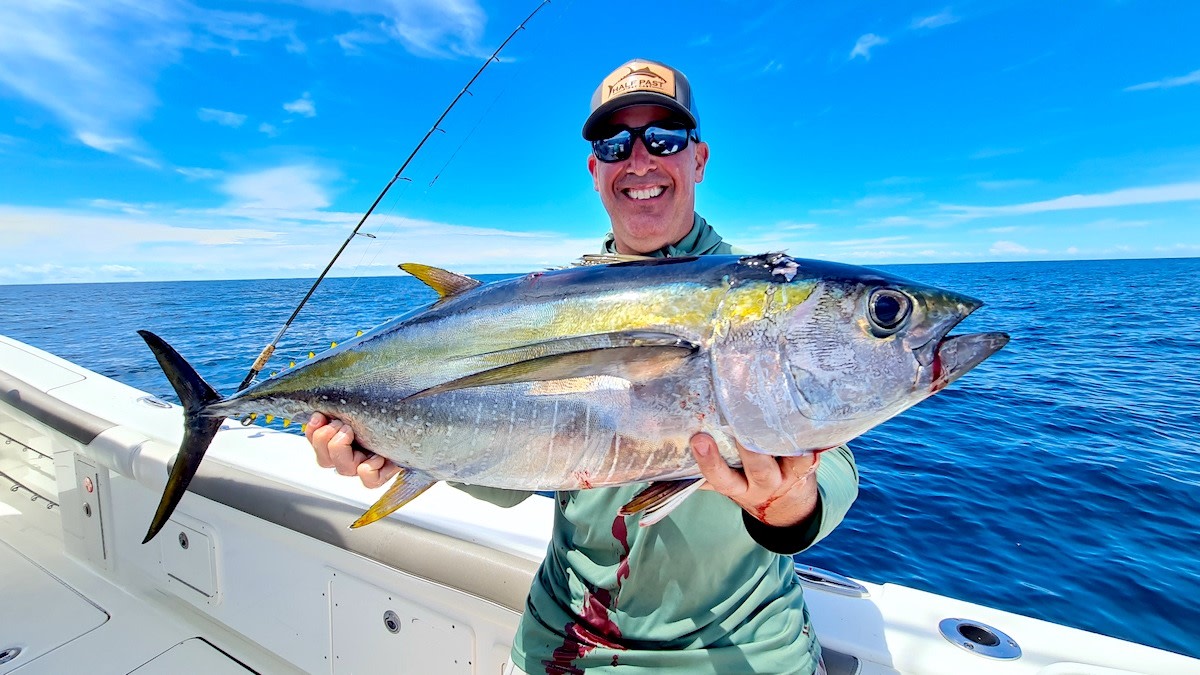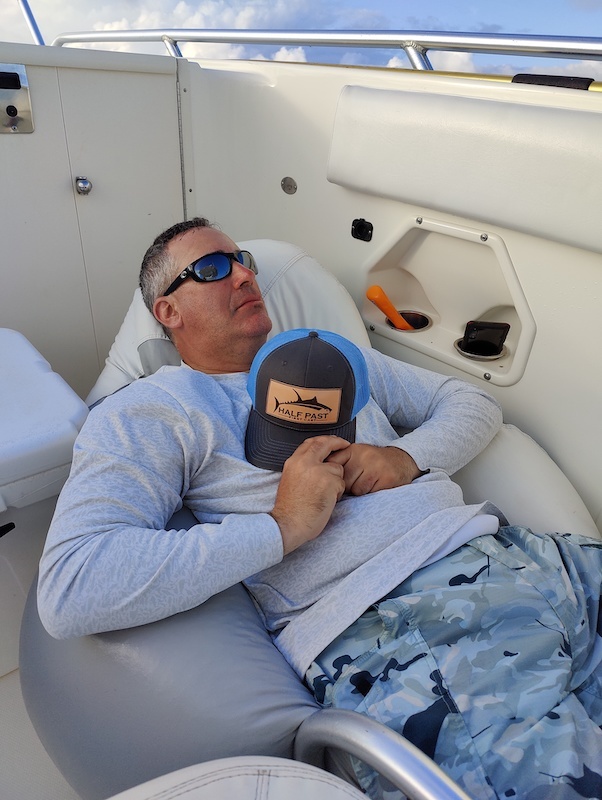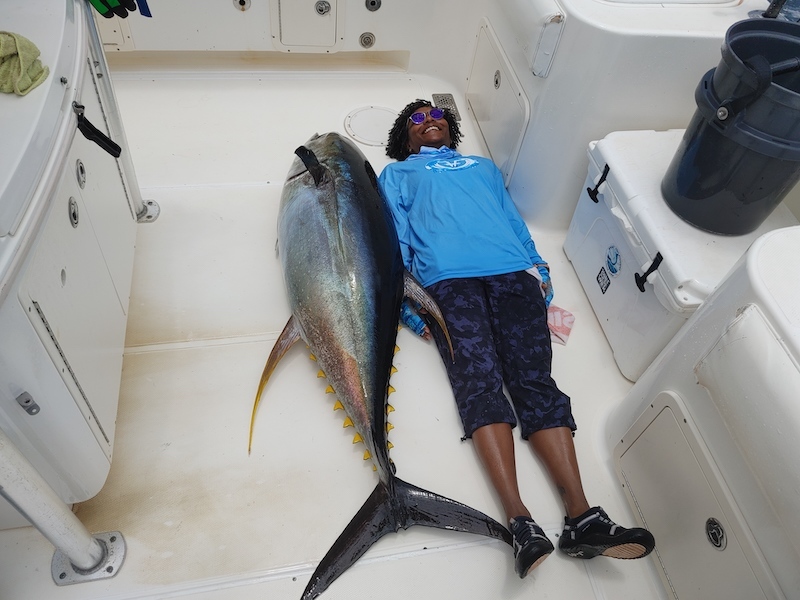
Here is the very epitome of a first-world problem: I cannot find a type of fishing that I do not enjoy. Of course I like some better than others, and will not be exceptionally disappointed if I never go ice fishing or lob giant hunks of plastic for muskies again. Despite the fact that just about any day on the water gets me excited, from perch-jerking in a parking lot mud puddle on up to tarpon, there’s fishing—and then there’s hand combat with something as big as you are.
My first foray into tuna fishing, in Panama at age 51, slapped me up against the rev limiter.
You see, the longer you fish, the harder it is to get completely blown away by something new. If you’ve caught marlin or taimen or tigerfish, you may still like catching catfish or stocker trout, but it’s never going to impress you in the same way. Bass fishing courses through my veins. It’s part of who I am, but nothing that happens while fishing for bass is ever going to meaningfully surprise me. Therein lies the rub: If you’re not having the occasional “ah-ha” moment on the water, then you’re just going through the motions. You need those jolts of energy to help you remember why you fell in love with the sport in the first place, why you couldn’t live without it.
Sorry bassheads (I’m one of you), but no largemouth or smallmouth is going to tax your arms or your tackle the way that a tuna will. And while I’m certainly in awe of the bass pros who can break down a massive impoundment in two and a half days, finding more and bigger bass than anyone else, there’s something more visceral about pelagics. Seeing them on the radar, the seeing the fish leapfrogging one another in a frenzied rush to decimate a bait ball; I felt like I was in Jurassic Park, witnessing something so damn prehistoric that it gave me the sweats. It was athletic in a way that my everyday angling is not, and that’s what made it so incredibly tiring.

Most importantly, it made me think about all of the other angling that I do, and ways to improve my craft.
Lessons from Tuna Fishing These are a few things tuna taught me that carry forward into all the fishing that I’ll do from now on:
- Make the first cast count. Just because the fish are flying ass-over-elbows to get the bait doesn’t mean they’ll stick around for long. Set yourself in position and land the plug on the X before they spook or scram.
- Keep it in the strike zone. The yellowfins were voracious but could be surprisingly picky. For every bomb detonation of a strike, there’d be a fish that would miss it completely. If I yanked too hard, especially in waves, the lure would lose its cadence.
- Match the hatch. Big bait, big fish, right? Well, when they’re feeding on finger-sized squid instead of smaller fish, sometimes a big offering gets ignored.
- You’re only as good as your weakest link. A 100-pound torpedo made of muscle pulling against you will test every connection in between—from the joining of braid to leader, to your knots, to the split-rings holding your trebles.
- Invest in the good stuff. Woe be they whose drag is not butter smooth. You’ll get ripped right into the drink. You may be able to get away with fewer bearings or cheaper line on crappies, but not when the big boys are in the mix.
- Don’t let your guard down. Just when we thought some of the tuna were whipped and gaff-ready, they’d take off on another line-peeling run. That’s when losses occurred, just like I’ve seen so many bass get loose when anglers had them approaching the net and suddenly let off the pressure.
- Get in shape. At the end of each day, I’d pass out in a beanbag for the hour-long ride back to the lodge, dead to the world. That rest was needed to recuperate for the next outing. As the days progressed and I got more tired, my casting became sloppier. A 130-pound tuna totally kicked my butt. If I’d hit the gym more before the trip I might have conquered a few more fish.
- Go where it’s best. Even if you’re not headed to Panama, the key to getting the most out of a new form of fishing is to go where it excels and to do it at prime time. Hunting down a single bite is a recipe for disaster.
- Take it all in. The worst residue of my bass tournament years is that I’m often so laser-focused on the next fish that I miss key clues. Nothing else matters. The problem is that everything else matters. When you stop taking in the scenery, the changes in water color, the other wildlife, you lose valuable information that makes success more likely.
- Fishing is supposed to be fun. If it’s no longer enjoyable, find something else to do, or at least find a new species or technique to light you up.
Honestly, each day as we made the first hour-long run out to the tuna grounds, I got those same jitters in my stomach that had populated it in the ‘90s, back when all week long, all I could think about was blasting off at Saturday’s fruit-jar bass tournament.

On the tuna boat, Captain Shane Jarvis would see birds diving and dolphins breaking the surface several miles away on his radar and he’d yell at us to hold on while he gunned that sucker across the pond. I’d be standing on the bow as we skipped across the waves, looking down at dolphins somehow staying in front of the boat but never getting hit. Even though I’m hardly fleet afoot, it felt like I was floating. My knees bent magically with each little bit of chop, my hands gripped the rails without getting white knuckles.
He’d pull up in front of the melee, we’d fire off casts, rip on the poppers, and would either get our shit absolutely blown up by a rampaging fish or they’d scurry off and the process would start up all over again. Magical. Invigorating. The most exciting fishing I’ve ever done.
What I Liked About Tuna
• They eat topwaters. Seriously, if you don’t like surface blow-ups, I don’t want to be your friend. • They pull like crazy. Do you think your spinning gear is up to the test? Try it out on tuna. You’ll learn more about fighting fish in 10 minutes than you can learn in a year fishing for bass.

• You can eat them when you’re done and claim world domination. In my opinion, no fish tastes better. • The only disappointing thing is that they didn’t jump like sailfish, peacock bass, or Alaskan rainbow trout.
Tuna North, South, East, and West So you want get in on the tuna deal, and don’t want to venture to Panama? No matter where you live in North America, there are options off the nearest coast. Here are some of the best:
North: Prince Edward Island, Bluefin This idyllic island off New Brunswick and Nova Scotia is where the true giants live, and your chances of catching a grander aren’t unreasonable. When you’re tired of winching on them you can hand-feed tuna that weigh three or four times as much as you.
South: Venice, Louisiana, Yellowfin Less than two hours south of New Orleans, at the end of the road, lives one of the most storied and diverse fisheries anywhere. You can chase quality largemouth bass and trophy redfish in the marsh or head out to the rigs and humps to chase sweet-tasting yellowfin tuna.
East: Beachfront, False Albacore One of the greatest entry points to light tackle or fly fishing in the salt is the albie, and fortunately for East Coast anglers, you can catch them along almost the whole length of I-95. No boat required—though getting out in one certainly doesn’t hurt.
Southwest: California Long-Range, Bluefin Lots of my West Coast friends, including some of the fishiest and most well-traveled dudes I know, take long-range trips out of San Diego for everything from day trips up to three weeks of hardcore angling. This is party boat fishing taken to the extreme. This bluefin population is healthy and even ventures closer to shore on occasion.
Northwest: Washington, Albacore Dozens of trips per day head out of Westport and other marinas along Washington and Oregon, headed 20 to 50 miles offshore for jam-packed albacore fishing. These smaller tuna are plentiful, strong, and delicious.
Three Tuna Poppers to Try Rapala X-Rap Magnum Xplode: Rapala’s legendary quality meets the salt in this cup-mouthed giant (go for the 6 ¾-inch model if bait is big, 5 ¼ if they’re feeding on smaller prey). It comes in great colors replicating common forage including sardines, mullet, and flying fish.
Yo-Zuri Mag Popper: This was my gateway drug to tuna addiction. It has a weight transfer system that allows you to cast a mile in any direction.
K-Lures: My friend Kermett Adams in California made me some indestructible lures for chasing Amazonian peacock bass, and when I asked for tuna poppers he was up to the task. He can even customize them with your logo or name so Charlie the Tuna knows who’s knocking.
Three More Things You May Need Deck shoes: If you’re running around the boat trying to keep up with a hard-charging fish, bare feet will not only be slippery but may also get stubbed on cleats and other accessories. Protect your toes.
Sun gloves: Not necessarily for the sun, (although they help there, too) but to keep your hands from blistering up during a day of hard casting and winding.
Good laundry detergent: When you put a gaff through a tuna’s head or side and blood starts spurting, you don’t want to be wearing your Sunday best. You will want to wash up good after a day or two of this sweaty, slimy, enthralling work.




